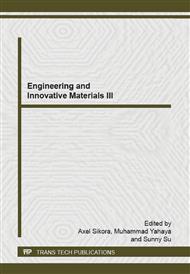p.219
p.224
p.229
p.237
p.242
p.247
p.252
p.258
p.263
Embodied Carbon Potential of Conventional Construction Materials Used in Typical Malaysian Single Storey Low Cost House Using Building Information Modeling (BIM)
Abstract:
The housing sector of Malaysia plays a very prominent role in meeting the major requirements of accommodation throughout the country. However, this sector consumes a handsome amount of resources among which the construction materials are a prime resource. Besides the valuable contribution of housing sector, the building materials used make a significant contribution in embodied CO2 emissions. In order to access the magnitude of CO2 from housing sector, it is necessary that effect of embodied CO2 emissions from the materials used in conventional housing construction in Malaysia shall also be studied. This study focuses on the embodied CO2 emission from the materials used in construction of a typical low cost house which are commonly adopted in Malaysia. The virtual model of selected single storey low cost house was developed using Building Information Modeling (BIM) concept. The results highlighted that bricks (37%), concrete (22%), mild steel (19%), steel rebar (7%) and roof tiles (6%) are the top five materials responsible for CO2 emissions. The overall contribution of single storey house in terms of embodied CO2 emissions is observed to be 34 kg-CO2 / sq. ft. This study has helped to highlight the potential contribution of conventional materials used in typical housing sector of Malaysia.
Info:
Periodical:
Pages:
242-246
Citation:
Online since:
October 2014
Price:
Сopyright:
© 2014 Trans Tech Publications Ltd. All Rights Reserved
Share:
Citation:


